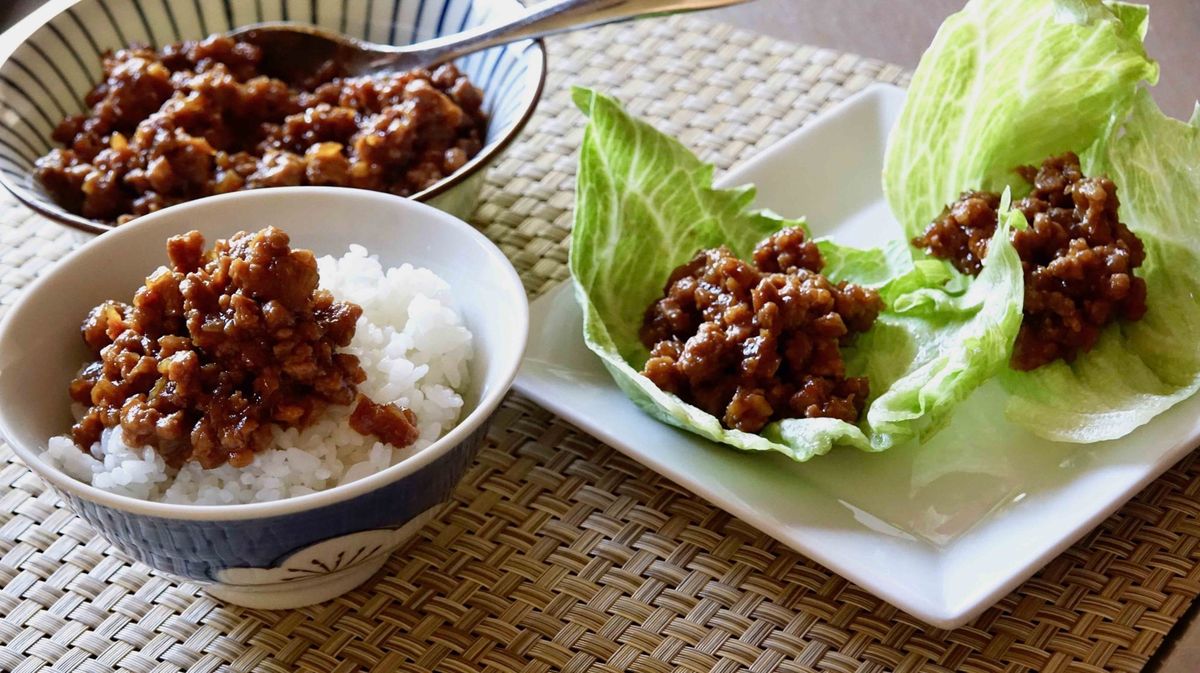This Japanese meat sauce is a delightful fusion of flavors that brings a unique twist to your traditional meat sauce. Perfect for serving over pasta or rice, this dish combines the savory taste of ground beef with the umami-rich notes of soy sauce and mirin, creating a comforting and satisfying meal.
Some ingredients in this recipe might not be staples in every household. Soy sauce and mirin are essential for achieving the authentic Japanese flavor. Mirin is a sweet rice wine used in Japanese cooking, and it can usually be found in the Asian section of most supermarkets. Make sure to pick these up if you don't already have them in your pantry.

Ingredients For Japanese Meat Sauce Recipe
Ground beef: Provides the hearty base for the sauce.
Onion: Adds sweetness and depth of flavor.
Garlic: Enhances the overall taste with its aromatic quality.
Crushed tomatoes: Forms the tomato base of the sauce.
Soy sauce: Adds umami and saltiness.
Mirin: Contributes a subtle sweetness and depth.
Sugar: Balances the acidity of the tomatoes.
Salt: Enhances all the flavors.
Black pepper: Adds a hint of spice.
Technique Tip for This Recipe
When browning the ground beef, make sure to break it up into small pieces using a wooden spoon or spatula. This ensures even cooking and prevents large clumps from forming. Additionally, allowing the onion to cook until it's fully translucent will enhance its sweetness, adding depth to the meat sauce.
Suggested Side Dishes
Alternative Ingredients
ground beef - Substitute with ground turkey: Ground turkey is a leaner option and provides a similar texture and flavor profile.
ground beef - Substitute with ground pork: Ground pork adds a slightly different flavor but maintains the richness and texture needed for the sauce.
finely chopped onion - Substitute with shallots: Shallots offer a milder and slightly sweeter taste, which can complement the other flavors in the sauce.
finely chopped onion - Substitute with leeks: Leeks provide a subtle onion flavor and a bit of sweetness, adding depth to the sauce.
minced garlic - Substitute with garlic powder: Garlic powder can be used in a pinch, though it lacks the fresh, pungent flavor of minced garlic.
minced garlic - Substitute with shallots: Shallots can provide a mild garlic-like flavor along with their onion notes.
crushed canned tomatoes - Substitute with tomato sauce: Tomato sauce can be used for a smoother consistency, though it may be less chunky.
crushed canned tomatoes - Substitute with fresh tomatoes: Fresh tomatoes can be chopped and cooked down to achieve a similar texture and flavor.
soy sauce - Substitute with tamari: Tamari is a gluten-free alternative that offers a similar umami flavor.
soy sauce - Substitute with coconut aminos: Coconut aminos provide a slightly sweeter and less salty alternative to soy sauce.
mirin - Substitute with sake and sugar: A mix of sake and a bit of sugar can mimic the sweet and tangy flavor of mirin.
mirin - Substitute with rice vinegar and sugar: Rice vinegar with added sugar can replicate the acidity and sweetness of mirin.
sugar - Substitute with honey: Honey can add a natural sweetness and a bit of depth to the sauce.
sugar - Substitute with maple syrup: Maple syrup provides a unique sweetness and can add a subtle complexity to the sauce.
salt - Substitute with soy sauce: Soy sauce can add both saltiness and umami flavor, reducing the need for additional salt.
salt - Substitute with sea salt: Sea salt can be used as a direct substitute, offering a slightly different mineral profile.
black pepper - Substitute with white pepper: White pepper provides a similar heat but with a slightly different flavor profile.
black pepper - Substitute with red pepper flakes: Red pepper flakes can add a bit of heat and a different kind of spiciness to the sauce.
Alternative Recipes Similar to This Dish
How to Store or Freeze This Dish
- Allow the Japanese meat sauce to cool completely before storing. This helps prevent condensation, which can lead to a watery sauce.
- Transfer the cooled meat sauce into airtight containers or heavy-duty freezer bags. Make sure to leave some space at the top of the container or bag to allow for expansion as the sauce freezes.
- Label each container or bag with the date and contents. This will help you keep track of how long the sauce has been stored and ensure you use it within a safe timeframe.
- Store the meat sauce in the refrigerator if you plan to use it within 3-4 days. For longer storage, place the containers or bags in the freezer, where the sauce can be kept for up to 3 months.
- When ready to use, thaw the frozen sauce in the refrigerator overnight. For a quicker option, you can also use the defrost setting on your microwave.
- Reheat the sauce in a saucepan over medium heat, stirring occasionally until it reaches the desired temperature. You can also reheat it in the microwave, stirring every minute to ensure even heating.
- If the sauce appears too thick after reheating, add a splash of water or broth to reach the desired consistency. Adjust the seasoning if necessary.
- Serve the reheated Japanese meat sauce over your choice of pasta or rice, and enjoy a delicious meal that tastes just as good as when it was freshly made.
How to Reheat Leftovers
For stovetop reheating, place the Japanese meat sauce in a saucepan over medium heat. Add a splash of water or broth to keep it from drying out. Stir occasionally until heated through, about 5-7 minutes.
To reheat in the microwave, transfer the meat sauce to a microwave-safe dish. Cover with a microwave-safe lid or plastic wrap with a small vent. Heat on high for 2-3 minutes, stirring halfway through to ensure even heating.
For oven reheating, preheat your oven to 350°F (175°C). Place the meat sauce in an oven-safe dish and cover with aluminum foil. Bake for about 20 minutes or until heated through, stirring halfway.
If you have a slow cooker, transfer the meat sauce to the slow cooker and set it on low. Heat for 1-2 hours, stirring occasionally, until the sauce is warmed through.
For a quick and easy method, use a double boiler. Place the meat sauce in a heatproof bowl over a pot of simmering water. Stir occasionally until the sauce is hot, which should take about 10-15 minutes.
Essential Tools for This Recipe
Saucepan: Use this to cook the ground beef and simmer the meat sauce.
Wooden spoon: Ideal for stirring the ingredients without scratching the saucepan.
Knife: Essential for finely chopping the onion and mincing the garlic.
Cutting board: Provides a safe surface for chopping the onion and garlic.
Measuring spoons: Use these to measure out the soy sauce, mirin, sugar, salt, and black pepper accurately.
Can opener: Necessary for opening the can of crushed tomatoes.
Mixing bowl: Handy for holding chopped ingredients before adding them to the saucepan.
Spatula: Useful for scraping down the sides of the saucepan to ensure all ingredients are well mixed.
Timer: Helps keep track of the 20-minute simmering time.
Serving spoon: Perfect for serving the meat sauce over pasta or rice.
Time-Saving Tips for This Recipe
Pre-cook the beef: Brown the ground beef in advance and store it in the fridge. This will save you time when you start cooking.
Use a food processor: Finely chop the onion and garlic using a food processor to speed up prep time.
Opt for canned tomatoes: Use crushed canned tomatoes instead of fresh ones to cut down on prep work.
Measure ingredients ahead: Measure out the soy sauce, mirin, sugar, salt, and black pepper before you start cooking to streamline the process.

Japanese Meat Sauce Recipe
Ingredients
Main Ingredients
- 500 g Ground Beef
- 1 medium Onion finely chopped
- 2 cloves Garlic minced
- 400 g Canned Tomatoes crushed
- 2 tablespoon Soy Sauce
- 1 tablespoon Mirin
- 1 tablespoon Sugar
- 1 teaspoon Salt
- 0.5 teaspoon Black Pepper
Instructions
- 1. Heat a saucepan over medium heat and add ground beef. Cook until browned.
- 2. Add finely chopped onion and minced garlic. Cook until the onion is translucent.
- 3. Add crushed tomatoes, soy sauce, mirin, sugar, salt, and black pepper. Stir well.
- 4. Reduce heat to low and simmer for 20 minutes, stirring occasionally.
- 5. Serve over pasta or rice.
Nutritional Value
Keywords
Suggested Appetizers and Desserts
More Amazing Recipes to Try 🙂
- Japanese Spicy Ramen Recipe45 Minutes
- Japanese Fish Marinade Recipe30 Minutes
- Manju Recipe35 Minutes
- Korokke (Japanese Croquette) Recipe50 Minutes
- Japanese Chocolate Banana Recipe15 Minutes
- Japanese Miso Soup Recipe20 Minutes
- Japanese Yogurt Cake Recipe1 Hours
- Japanese Tuna Sushi Recipe50 Minutes

Leave a Reply